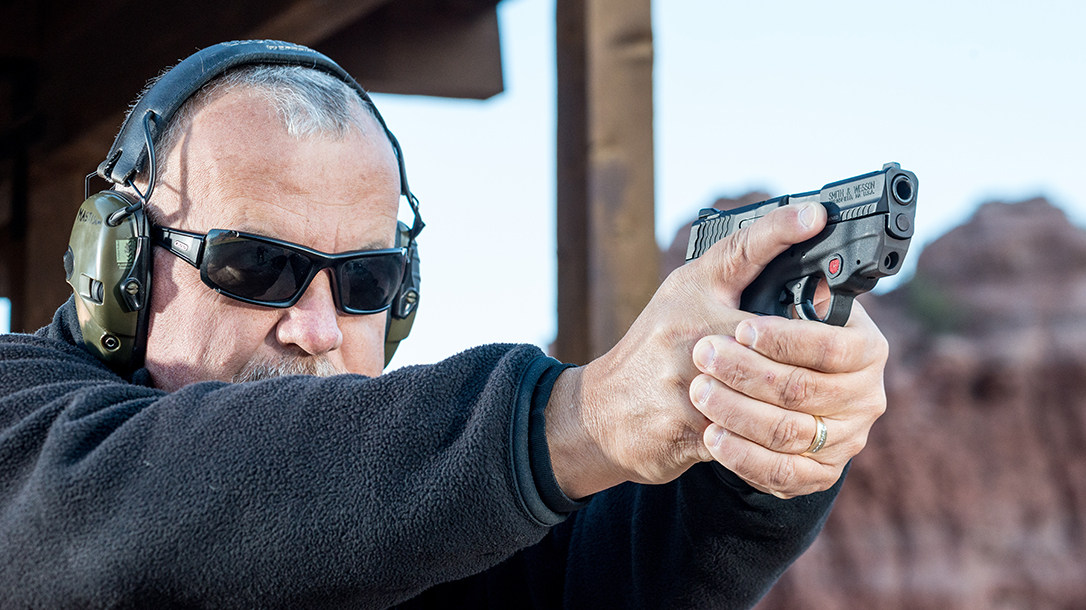As experienced shooters, our heads sometimes explode when we watch movies and television shows. The hero or heroine ends up pulling out their trusty blaster to shoot the bad guy and there it is, a pistol grip that is so horrible you wonder how they are even able to hold the gun, let alone shoot it. Suffice it to say, no one teaches these actors how to hold a handgun.
This usually shows up as “tea cupping” where the shooter puts the base of the gun into the palm of the support hand.
Advertisement — Continue Reading Below
While I could rant on, I know I am preaching to the choir and will save the ink. The upside of this, however, is that it spurs discussion of just what makes a “good” pistol grip and how to hold a handgun. While opinions can vary, there are a couple ways to hold your semi-automatic pistol that work well.
Foundations of a Good Pistol Grip

Handguns can be a difficult weapon to shoot accurately. They are relatively small and most have a trigger pull that is more than twice the actual weight of the gun. The best way to learn how to hold a handgun is to start with a good grip.
Advertisement — Continue Reading Below
A good pistol grip is critical if we are to enjoy any sort of accuracy and follow-up shots.
The best grip will have the barrel generally in line with the bones in your strong side forearm to begin with. The web of your primary hand should be high on the back of the gun and fully under the back strap. This is the base for the strong side hand regardless of what you choose to do with your support side hand. On that point there are two options that work best.
Thumbs Forward

Advertisement — Continue Reading Below
First is the grip used by most professional and serious shooters. It is referred to as “thumbs forward.”
As you grip the gun with your strong side, your thumb should be pointing down the slide. The support side hand will have equally as firm a grip.
Your fingers will wrap over the top of your first hand and your thumb will be pointed down the slide as well. The thumb from your strong side hand will now rest on top of the muscle of your support side hand.
Advertisement — Continue Reading Below
This “thumbs forward” grip allows the large muscle of your thumb to settle up against the gun. This in turn will create a full 360-degree grip with no weak spots or openings. This is the key to not only accurate shooting, but to fast follow-up shots as well.
Interlocked Thumbs

A second pistol grip that is both common and reliable is the “interlocked thumbs” grip.
Advertisement — Continue Reading Below
The base of this grip starts with an identical setup with the strong side hand. The difference is all in the thumb position of the support side hand.
Instead of running the support side thumb down the side of the gun, it lays over the top of the strong side thumb. This grip still allows us a good 360-degree grip and is more comfortable for some people.
Advertisement — Continue Reading Below
The “interlocked thumbs” grip is especially good if the shooter has wrist or shoulder issues.
It does make extending both arms equally more of a challenge, but it has served people well for decades.
Having a Firm Grip

Advertisement — Continue Reading Below
Regardless of what grip you choose, it is important to be consistent in your hand position. This comes with practice and repetition. The thing that brings these grips together though is how firmly you hold the gun.
There are volumes of opinions on the topic of how to hold a handgun, but I will speak from experience and say grab the gun like you mean it. We want to manage recoil and keep our gun on sight as much as possible. Because of that, we need to have a firm grip on the gun.
Some are concerned with “over gripping” the gun and I can understand that. We don’t want to crush the gun, but we can in no way just gently hold it either. The lighter the grip, the more the gun will jump during recoil.
Advertisement — Continue Reading Below
If you build a solid platform with your body and use a firm grip, the recoil will be absorbed by the body and can be more easily managed.
Remember that we are only trying to manage the recoil. Unless it is a very small caliber handgun, we are trying to do our best to work with it.
Regardless of hand strength, the gun is going to move because of the speed of the action. A good grip is the foundation that recoil management is built on.

Final Thoughts
Of course, there are other grips out there that people use effectively. What I find, however, is there are grips people have developed on their own over time.
I have seen some very “interesting” grips over my years as an instructor. While not traditional, some of the shooters using those grips performed very well.
In the end though I encourage shooters to use one of the two grips we have discussed. This is especially true if you are a new shooter just learning the fundamentals.
A good pistol grip is the building block for fast and accurate shooting — that translates to enjoyable shooting for a lifetime.
For more, please visit ForceOptionsUSA.com.























